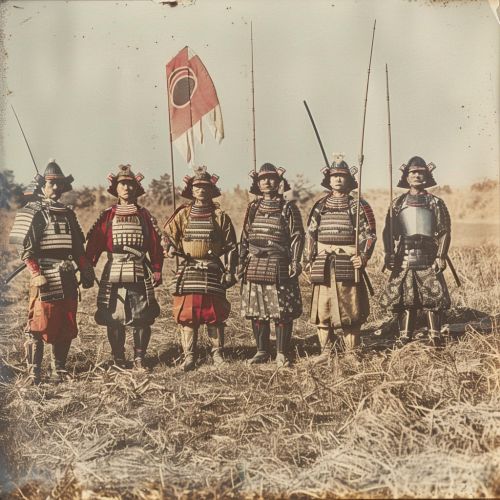Seven Samurai
Historical Context
"Seven Samurai" is a seminal 1954 Japanese film directed by Akira Kurosawa. The film is set in 1586 during the Sengoku period of Japanese history, a time marked by social upheaval, political intrigue, and near-constant military conflict. This era, also known as the Warring States period, saw the rise of powerful warlords (daimyō) and the decline of the central authority of the shogunate.
Plot Overview
The narrative of "Seven Samurai" revolves around a small village that is frequently raided by bandits. Desperate for protection, the villagers seek the help of samurai, who are masterless warriors known as rōnin. They manage to recruit seven samurai, each with unique skills and backgrounds, to defend their village. The film meticulously details the preparation for the battle, the training of the villagers, and the eventual confrontation with the bandits.
Characters
Kambei Shimada
Kambei Shimada, portrayed by Takashi Shimura, is the leader of the seven samurai. He is a seasoned warrior who has seen many battles and is characterized by his wisdom and tactical acumen. Kambei's leadership is crucial in organizing the defense of the village.
Kikuchiyo
Played by Toshiro Mifune, Kikuchiyo is a complex character who initially appears as a brash and unreliable figure. However, as the story progresses, it is revealed that he is a farmer's son who aspires to be a samurai. His character arc is one of the most compelling in the film, providing both comic relief and emotional depth.
Gorobei Katayama
Gorobei Katayama, portrayed by Yoshio Inaba, is a skilled archer and Kambei's right-hand man. He is instrumental in the strategic planning and execution of the village's defense.
Shichiroji
Daisuke Katō plays Shichiroji, a former lieutenant of Kambei. Their reunion is marked by mutual respect and camaraderie, and Shichiroji's experience proves invaluable in the battle against the bandits.
Heihachi Hayashida
Heihachi Hayashida, played by Minoru Chiaki, is the samurai responsible for maintaining morale among the group. His cheerful disposition and carpentry skills make him a beloved figure among the villagers.
Kyūzō
Seiji Miyaguchi portrays Kyūzō, a master swordsman whose stoic demeanor and unparalleled skill in combat make him one of the most formidable members of the group. His dedication to the samurai code of Bushido is evident throughout the film.
Katsushirō Okamoto
Isao Kimura plays Katsushirō Okamoto, a young and inexperienced samurai who idolizes Kambei. His journey from naive youth to seasoned warrior is a significant subplot in the film.


Cinematic Techniques
"Seven Samurai" is renowned for its innovative cinematic techniques, many of which have influenced subsequent films across various genres. Kurosawa's use of deep focus cinematography, where multiple planes of action are in sharp focus, allows for complex compositions and dynamic storytelling. The film also employs telephoto lenses to compress space and create a sense of urgency during battle scenes.
The editing style, particularly the use of wipe transitions, is another hallmark of Kurosawa's direction. These transitions help to maintain the film's brisk pace and provide a visual rhythm that complements the narrative structure.
Themes
Honor and Duty
The film explores the concept of honor and duty, central tenets of the samurai code of Bushido. Each samurai's decision to defend the village, despite the lack of monetary reward, underscores their commitment to these principles.
Class Struggle
"Seven Samurai" delves into the social dynamics between the samurai and the villagers. The initial mistrust and eventual mutual respect highlight the class struggle prevalent during the Sengoku period. The film portrays the samurai as noble yet flawed individuals, while the villagers are depicted as both vulnerable and resourceful.
Sacrifice
The theme of sacrifice is omnipresent in "Seven Samurai." The samurai risk their lives to protect the villagers, and several characters meet tragic ends. This theme is poignantly encapsulated in Kambei's reflection at the film's conclusion: "In the end, we lost this battle too. The victory belongs to the peasants, not to us."
Influence and Legacy
"Seven Samurai" has had a profound impact on global cinema. Its narrative structure, characterized by the assembly of a diverse group of heroes to achieve a common goal, has been emulated in numerous films, including The Magnificent Seven, a Western adaptation released in 1960. The film's influence extends to various genres, from action-adventure to science fiction.
Kurosawa's meticulous attention to detail, character development, and innovative techniques have made "Seven Samurai" a subject of extensive study in film schools and among cinephiles. The film's enduring legacy is a testament to its artistic and cultural significance.
